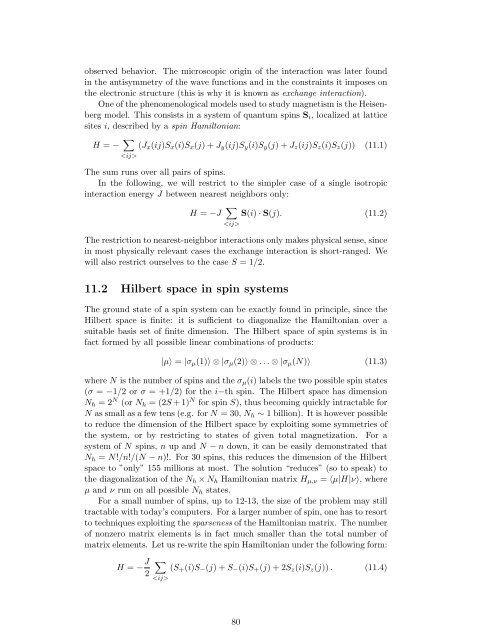Numerical Methods in Quantum Mechanics - Dipartimento di Fisica
Numerical Methods in Quantum Mechanics - Dipartimento di Fisica
Numerical Methods in Quantum Mechanics - Dipartimento di Fisica
You also want an ePaper? Increase the reach of your titles
YUMPU automatically turns print PDFs into web optimized ePapers that Google loves.
observed behavior. The microscopic orig<strong>in</strong> of the <strong>in</strong>teraction was later found<br />
<strong>in</strong> the antisymmetry of the wave functions and <strong>in</strong> the constra<strong>in</strong>ts it imposes on<br />
the electronic structure (this is why it is known as exchange <strong>in</strong>teraction).<br />
One of the phenomenological models used to study magnetism is the Heisenberg<br />
model. This consists <strong>in</strong> a system of quantum sp<strong>in</strong>s S i , localized at lattice<br />
sites i, described by a sp<strong>in</strong> Hamiltonian:<br />
H = − ∑ <br />
(J x (ij)S x (i)S x (j) + J y (ij)S y (i)S y (j) + J z (ij)S z (i)S z (j)) (11.1)<br />
The sum runs over all pairs of sp<strong>in</strong>s.<br />
In the follow<strong>in</strong>g, we will restrict to the simpler case of a s<strong>in</strong>gle isotropic<br />
<strong>in</strong>teraction energy J between nearest neighbors only:<br />
H = −J ∑ <br />
S(i) · S(j). (11.2)<br />
The restriction to nearest-neighbor <strong>in</strong>teractions only makes physical sense, s<strong>in</strong>ce<br />
<strong>in</strong> most physically relevant cases the exchange <strong>in</strong>teraction is short-ranged. We<br />
will also restrict ourselves to the case S = 1/2.<br />
11.2 Hilbert space <strong>in</strong> sp<strong>in</strong> systems<br />
The ground state of a sp<strong>in</strong> system can be exactly found <strong>in</strong> pr<strong>in</strong>ciple, s<strong>in</strong>ce the<br />
Hilbert space is f<strong>in</strong>ite: it is sufficient to <strong>di</strong>agonalize the Hamiltonian over a<br />
suitable basis set of f<strong>in</strong>ite <strong>di</strong>mension. The Hilbert space of sp<strong>in</strong> systems is <strong>in</strong><br />
fact formed by all possible l<strong>in</strong>ear comb<strong>in</strong>ations of products:<br />
|µ〉 = |σ µ (1)〉 ⊗ |σ µ (2)〉 ⊗ . . . ⊗ |σ µ (N)〉 (11.3)<br />
where N is the number of sp<strong>in</strong>s and the σ µ (i) labels the two possible sp<strong>in</strong> states<br />
(σ = −1/2 or σ = +1/2) for the i−th sp<strong>in</strong>. The Hilbert space has <strong>di</strong>mension<br />
N h = 2 N (or N h = (2S + 1) N for sp<strong>in</strong> S), thus becom<strong>in</strong>g quickly <strong>in</strong>tractable for<br />
N as small as a few tens (e.g. for N = 30, N h ∼ 1 billion). It is however possible<br />
to reduce the <strong>di</strong>mension of the Hilbert space by exploit<strong>in</strong>g some symmetries of<br />
the system, or by restrict<strong>in</strong>g to states of given total magnetization. For a<br />
system of N sp<strong>in</strong>s, n up and N − n down, it can be easily demonstrated that<br />
N h = N!/n!/(N − n)!. For 30 sp<strong>in</strong>s, this reduces the <strong>di</strong>mension of the Hilbert<br />
space to ”only” 155 millions at most. The solution “reduces” (so to speak) to<br />
the <strong>di</strong>agonalization of the N h × N h Hamiltonian matrix H µ,ν = 〈µ|H|ν〉, where<br />
µ and ν run on all possible N h states.<br />
For a small number of sp<strong>in</strong>s, up to 12-13, the size of the problem may still<br />
tractable with today’s computers. For a larger number of sp<strong>in</strong>, one has to resort<br />
to techniques exploit<strong>in</strong>g the sparseness of the Hamiltonian matrix. The number<br />
of nonzero matrix elements is <strong>in</strong> fact much smaller than the total number of<br />
matrix elements. Let us re-write the sp<strong>in</strong> Hamiltonian under the follow<strong>in</strong>g form:<br />
H = − J 2<br />
∑<br />
<br />
(S + (i)S − (j) + S − (i)S + (j) + 2S z (i)S z (j)) . (11.4)<br />
80
















